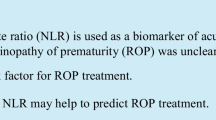Abstract
Purpose
To investigate blood monocyte counts as a risk factor for retinopathy of prematurity (ROP) treatment.
Design
Retrospective cohort study.
Methods
Infants who underwent ROP screening at Shiga University of Medical Science Hospital between January, 2011 and July, 2021 were included in this study. Screening criteria were a gestational age (GA) < 32 weeks or birth weight (BW) < 1500 g. The week with the largest difference in monocyte counts between the infants with and without type 1 ROP determined based on the effect size. Multivariate logistic regression analysis was applied to investigate whether the monocyte counts constituted an independent risk factor for type 1 ROP. The objective variable was type 1 ROP, and the explanatory variables were GA, BW, infants’ infection, and Apgar score at 1 min and monocyte counts in the week with the largest monocyte-counts difference between the with- and without type 1 ROP groups.
Results
In total, 231 infants met the inclusion criteria. The monocyte counts in the fourth week after birth (4w MONO) exhibited the largest difference between infants with and without type 1 ROP. The analysis was performed on 198 infants, excluding 33 infants without 4w MONO data. Thirty-one infants had type 1 ROP, whereas 167 infants did not. BW and 4w MONO were significantly associated with type 1 ROP (odds ratio: 0.52 and 3.9, P < .001 and 0.004, respectively).
Conclusions
The 4w MONO was an independent risk factor for type 1 ROP and may be useful in follow-up of infants with ROP.

Similar content being viewed by others
References
Gilbert C. Retinopathy of prematurity: a global perspective of the epidemics, population of babies at risk and implications for control. Early Hum Dev. 2008;84:77–82.
Lyu J, Zhang Q, Jin H, Xu Y, Chen C, Ji X, et al. Aqueous cytokine levels associated with severity of type 1 retinopathy of prematurity and treatment response to ranibizumab. Graefes Arch Clin Exp Ophthalmol. 2018;256:1469–77.
Sato T, Kusaka S, Shimojo H, Fujikado T. Simultaneous analyses of vitreous levels of 27 cytokines in eyes with retinopathy of prematurity. Ophthalmology. 2009;116:2165–9.
Hu YX, Xu XX, Shao Y, Yuan GL, Mei F, Zhou Q, et al. The prognostic value of lymphocyte-to-monocyte ratio in retinopathy of prematurity. Int J Ophthalmol. 2017;10:1716–21.
Early Treatment For Retinopathy Of Prematurity Cooperative G. Revised indications for the treatment of retinopathy of prematurity: results of the early treatment for retinopathy of prematurity randomized trial. Arch Ophthalmol. 2003;121:1684–94.
Lynch DT, Hall J, Foucar K. How I investigate monocytosis. Int J Lab Hematol. 2018;40:107–14.
Kanda Y. Investigation of the freely available easy-to-use software ‘EZR’ for medical statistics. Bone Marrow Transplant. 2013;48:452–8.
Nichols BA, Bainton DF, Farquhar MG. Differentiation of monocytes. Origin, nature, and fate of their azurophil granules. J Cell Biol. 1971;50:498–515.
Kubota Y, Takubo K, Shimizu T, Ohno H, Kishi K, Shibuya M, et al. M-CSF inhibition selectively targets pathological angiogenesis and lymphangiogenesis. J Exp Med. 2009;206:1089–102.
Zhou Y, Yoshida S, Nakao S, Yoshimura T, Kobayashi Y, Nakama T, et al. M2 macrophages enhance pathological neovascularization in the mouse model of Oxygen-Induced Retinopathy. Invest Ophthalmol Vis Sci. 2015;56:4767–77.
Yoshida S, Yoshida A, Ishibashi T, Elner SG, Elner VM. Role of MCP-1 and MIP-1alpha in retinal neovascularization during postischemic inflammation in a mouse model of retinal neovascularization. J Leukoc Biol. 2003;73:137–44.
Deshmane SL, Kremlev S, Amini S, Sawaya BE. Monocyte chemoattractant protein-1 (MCP-1): an overview. J Interferon Cytokine Res. 2009;29:313–26.
Gao X, Wang YS, Li XQ, Hou HY, Su JB, Yao LB, et al. Macrophages promote vasculogenesis of retinal neovascularization in an oxygen-induced retinopathy model in mice. Cell Tissue Res. 2016;364:599–610.
Parrozzani R, Nacci EB, Bini S, Marchione G, Salvadori S, Nardo D, et al. Severe retinopathy of prematurity is associated with early post-natal low platelet count. Sci Rep. 2021;11:891.
Obata S, Matsumoto R, Kakinoki M, Sawada O, Sawada T, Saishin Y et al. Blood neutrophil-to-lymphocyte ratio as a risk factor in treatment for retinopathy of prematurity. Graefes Arch Clin Exp Ophthalmol. 2023; 261:951–7.
Ikeda H, Kuriyama S. Risk factors for retinopathy of prematurity requiring photocoagulation. Jpn J Ophthalmol. 2004;48:68–71.
Kaya MG. [Inflammation and coronary artery disease: as a new biomarker neutrophil/lymphocyte ratio]. Turk Kardiyol Dern Ars. 2013;41:191–2. (in Turkish).
Chen J, Smith LE. Retinopathy of prematurity. Angiogenesis. 2007;10:133–40.
Akdogan M, Ustundag Y, Cevik SG, Dogan P, Dogan N. Correlation between systemic immune-inflammation index and routine hemogram-related inflammatory markers in the prognosis of retinopathy of prematurity. Indian J Ophthalmol. 2021;69:2182–7.
Acknowledgements
We thank Shoji Momokawa and Jun Matsubayashi from the Center for Clinical Research and Advanced Medicine, Shiga University of Medical Science, for their advice on statistical analysis. We also thank Ryan Chastain-Gross, Ph.D., from Edanz (https://jp.edanz.com/ac) for editing a draft of this manuscript.
Author information
Authors and Affiliations
Corresponding author
Ethics declarations
Conflict of interest
S. Obata, None; R. Matsumoto, None; M. Kakinoki, None; O. Sawada, None; T. Sawada, None; Y. Saishin, None; T. Yanagi, None; Y. Maruo, None; and M. Ohji, None.
Additional information
Publisher’s Note
Springer Nature remains neutral with regard to jurisdictional claims in published maps and institutional affiliations.
Corresponding Author: Shumpei Obata
About this article
Cite this article
Obata, S., Matsumoto, R., Kakinoki, M. et al. Association between treatment for retinopathy of prematurity and blood monocyte counts. Jpn J Ophthalmol 67, 382–386 (2023). https://doi.org/10.1007/s10384-023-00992-x
Received:
Accepted:
Published:
Issue Date:
DOI: https://doi.org/10.1007/s10384-023-00992-x



